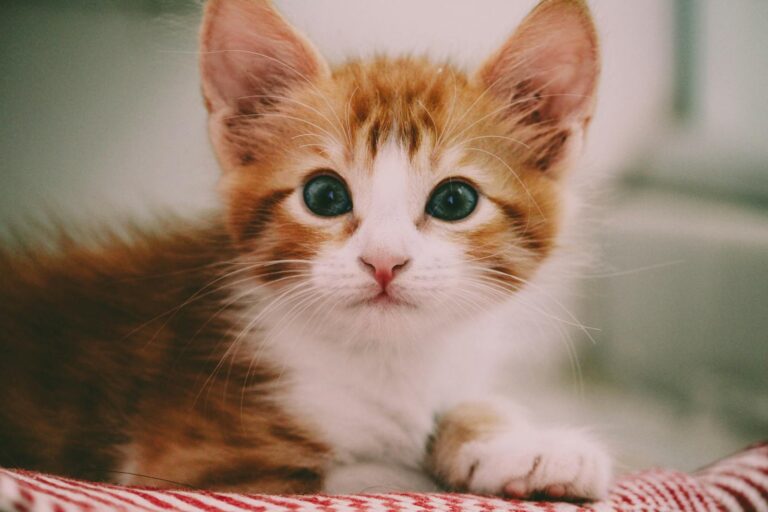Why Does My Cat Bite Me Out of Nowhere? Exploring the Unexpected Behavior
Cats are enigmatic companions, often keeping us on our toes with their unpredictable behaviors. One moment they’re purring in your lap, and the next, you find yourself nursing a surprise bite. If you’ve ever wondered, Why Does My Cat Bite Me Out of Nowhere?, you’re not alone. Understanding the reasons behind this sudden aggression can enhance your relationship with your feline friend and create a more harmonious living environment.
Understanding Feline Biting Behavior: An Overview
Biting is a complex behavior in cats that can stem from various factors, both psychological and physical. To comprehend why your cat might be inclined to bite without apparent provocation, it’s crucial to consider their natural instincts, social behaviors, and even their unique personalities.
Understanding your cat’s biting tendencies requires diving into their evolutionary background. Cats, by nature, are predators. Their ancestors relied on biting as a means of survival—whether it was to catch prey or defend themselves against threats. This instinctual behavior can manifest in domestic cats, particularly during play or moments of stress.
Moreover, recognizing the nuances of feline communication is vital. Unlike dogs, who may display overt signs of aggression, cats often exhibit subtle changes in body language and vocalizations before they decide to bite. Therefore, observing and interpreting these signals can help you mitigate incidents of unexpected bites.
The Evolution of Cat Behavior
Domestic cats share a lineage with wild cats, inheriting many traits that dictate their behavior. Over thousands of years of evolution, felines have adapted to life with humans while still retaining predatory instincts. This mix can sometimes lead to confusing behaviors like sudden biting.
Felines engage in two types of biting: playful and aggressive. Playful biting usually occurs when they are feeling energetic and playful, often mimicking the hunting behavior that they would exhibit in the wild. Aggressive biting, on the other hand, can result from fear or discomfort and can appear seemingly out of nowhere.
Understanding these distinctions allows cat owners to respond appropriately to their pet’s behavior, creating an environment where both parties feel comfortable and safe.
The Importance of Socialization
A cat’s biting behavior can also be influenced by their socialization experiences during kittenhood. Cats that were not adequately socialized may display defensive behaviors and react aggressively when they feel threatened. It’s essential to start early socialization for kittens, exposing them to various environments, people, and even other pets, which helps instill healthy behavioral patterns.
Cats learn through play, and interactions with their littermates teach them how to control their bite. A lack of this experience may lead to misunderstandings between owner and pet later in life, resulting in unexpected bites when boundaries are crossed.
The Role of Personality
Just like humans, each cat has a distinct personality that influences their behavior. Some cats are naturally more aloof or skittish, while others are outgoing and affectionate. Additionally, individual temperament can determine how a cat reacts in different situations. For example, a shy cat may resort to biting when overwhelmed, whereas a more assertive cat may use biting as a tactic to establish dominance.
Being aware of these differences allows owners to tailor their interactions with their cats, ensuring a nurturing and understanding environment that minimizes the likelihood of surprise bites.
Common Reasons for Sudden Cat Bites: Play Aggression and Overstimulation
Understanding the context in which a cat chooses to bite is crucial. Two common reasons include play aggression and overstimulation. Both situations can catch owners off guard, leading to confusion and frustration.
When a cat appears to bite out of nowhere, it’s often a reflection of their current mental state. Recognizing these states will empower owners to manage and redirect their feline’s energy effectively.
Play Aggression: The Hunter Within
Many cats exhibit play aggression, especially younger ones. During playtime, they channel their inner hunter, stalking, pouncing, and yes, biting. This form of aggression is perfectly normal behavior for a cat, but it can become problematic if not properly managed.
Play aggression typically occurs during interactive play sessions or when a cat becomes overly excited about a toy. They may view hands and feet as prey, leading to sudden nips or bites. Encouraging appropriate play is essential to avoid reinforcing unwanted biting behavior.
Instead of using hands as toys, provide your cat with a variety of engaging toys that simulate hunting. Natural wool felt cat toys provide a soft texture for biting and clawing.The natural lanolin in the wool attracts cats, and will entertain and satisfy their biting instinct.
Overstimulation: Too Much of a Good Thing
Another reason cats may bite unexpectedly is due to overstimulation. Felines can only handle so much petting, attention, and sensory input before reaching their threshold. This tipping point varies from cat to cat, and what may seem like harmless affection to one cat may feel overwhelming to another.
Signs your cat may be feeling overstimulated include twitching tails, flattened ears, and dilated pupils. Recognizing these signs before a bite occurs can help prevent escalation. When you notice your cat becoming agitated, it may be best to take a step back, allowing them some personal space to calm down.
Creating a low-stress environment with dedicated areas for your cat to retreat to can significantly reduce the chances of overstimulation. Soft blankets, cozy cave cat beds, or even high perches can provide a sanctuary for your cat to recharge away from interaction.
Redirecting Aggressive Behavior
Managing sudden biting behaviors involves proactive measures. When you identify triggers for play aggression and overstimulation, you can work on redirecting your cat’s focus. Instead of punishing them for biting, try to channel their energy into acceptable behaviors.
Engage your cat in regular play sessions, incorporating puzzle toys or interactive feeders that stimulate their mind and body while minimizing the urge to bite. Training techniques like clicker training can also reinforce positive behaviors and reduce impulsive biting tendencies.
Recognizing the difference between playful behavior and genuine aggression will allow you to navigate interactions with your cat more effectively.
Medical Considerations: Identifying Underlying Health Issues Causing Biting
Sometimes, sudden biting behavior can signal underlying health problems. If your cat starts exhibiting aggressive behavior out of character, it’s essential to consult a veterinarian to rule out any medical issues causing pain or discomfort.
Pain-Induced Aggression
Cats are masters at hiding pain, making it challenging for owners to detect. However, when a cat is in distress, they may lash out unexpectedly. Conditions such as arthritis, dental disease, or injuries can cause significant pain, leading to sudden aggressive behavior.
When assessing your cat’s health, look for subtle signs of discomfort, such as changes in appetite, grooming habits, or mobility. If you suspect pain may be the culprit behind their biting, a visit to the vet can help diagnose any underlying conditions.
Neurological Issues
In some cases, neurological disorders can cause changes in behavior, including increased aggression. Illnesses such as feline hyperesthesia syndrome or seizures may contribute to sudden biting incidents. It’s crucial to monitor your cat’s overall behavior and report any concerning changes to your veterinarian for proper evaluation and treatment.
Stress-Related Health Problems
Chronic stress can also manifest physically, leading to a myriad of health issues in cats. A stressed cat may experience gastrointestinal problems, urinary tract infections, or skin conditions, all of which can contribute to irritability and aggression.
Identifying stressors in your cat’s environment is key to alleviating their anxiety. Changes in routine, loud noises, or new household members can all affect your cat’s mental health. Addressing these stressors and providing a calming environment can help reduce the incidence of biting behaviors stemming from stress.
Environmental Factors: Stress and Anxiety-Related Biting Triggers
Environmental factors play a significant role in a cat’s behavior. Stress and anxiety can trigger biting incidents, often appearing to come out of nowhere. Understanding these factors allows owners to create a well-balanced home environment.
Identifying Stress Triggers
Cats are sensitive creatures that can react strongly to changes in their surroundings. New furniture, different scents, or even shifting household dynamics can lead to feelings of insecurity and anxiety. When a cat feels threatened, their instinct may prompt them to bite as a defense mechanism.
To help identify stress triggers, pay attention to your cat’s routines and behaviors. Keeping a journal of incidents can reveal patterns that point to specific stressors. Once identified, you can take steps to alleviate these concerns and promote a calmer atmosphere.
Creating a Safe Space
Providing a safe haven for your cat is essential in reducing anxiety-related biting. Designate a quiet area within your home where your cat can retreat when feeling overwhelmed. Equipping this space with familiar bedding, toys, and hiding spots allows your cat to feel secure and less anxious.
Consider utilizing pheromone diffusers or sprays designed to calm cats. These products can help mimic natural calming scents and create a relaxing atmosphere in your home, ultimately reducing the likelihood of stress-related aggression.
Engaging in Positive Interactions
Promoting positive interactions with your cat can significantly improve their emotional well-being. Spend quality time with your feline friend through gentle play, grooming, or simply being present. Offering treats and praise during calm moments reinforces a sense of security.
Additionally, implementing a consistent daily routine can help alleviate stress by providing predictability. Cats thrive on structure, and knowing what to expect can diminish anxiety levels, ultimately reducing the chances of sudden bites.
Interpreting Cat Body Language: Recognizing Warning Signs Before a Bite
One of the most effective ways to prevent unexpected biting is to learn to interpret your cat’s body language. Cats communicate primarily through their physical cues, and understanding these signs can help you navigate their emotional state and avoid potential conflicts.
The Tail Tells All
The position and movement of a cat’s tail often convey how they’re feeling. A straight-up tail indicates confidence and happiness, while a puffed-up tail suggests fear or agitation. When a cat’s tail begins to twitch or flick, it’s a sign that they may be overstimulated or annoyed.
If you notice your cat’s tail becoming rigid or swatting, heed these warnings. This behavior may indicate that your cat is about to bite if encouraged further. Recognizing these signs and responding immediately by giving them space can prevent an incident.
Ears and Eyes: The Subtle Signals
In addition to their tails, a cat’s ears and eyes provide valuable insight into their mood. Flattened ears signal discomfort or aggression, while perked-up ears indicate curiosity or interest. Dilated pupils can suggest excitement, fear, or aggression, depending on the context.
By paying attention to these signals in combination with their overall posture, you can gauge your cat’s emotional state and intervene before they reach a breaking point.
Vocalizations: Listening to Your Cat
Cats don’t just rely on body language; they also vocalize their feelings. Hissing, growling, or yowling can indicate that your cat is not happy with the situation at hand. Learning to recognize these sounds and their meanings is essential in preventing biting incidents.
If your cat vocalizes their displeasure, take it as a warning sign. Give them the space they need and reassess your interactions. By respecting their boundaries, you can foster a more positive relationship.
Prevention and Management Strategies: Reducing the Likelihood of Unexpected Bites
Preventing sudden bites requires a multifaceted approach that addresses environmental factors, social interactions, and play styles. By implementing effective strategies, you can reduce the likelihood of unexpected bites and strengthen the bond between you and your feline friend.
Establishing Healthy Play Habits
Encouraging healthy play habits is crucial in managing play aggression. Avoid using your hands as toys, and instead, opt for interactive toys that allow your cat to unleash their hunting instincts without biting you. Regularly scheduled play sessions are essential, as they help expend excess energy and reduce boredom.
Rotate toys regularly to maintain your cat’s interest and keep their playtime stimulating. Games that mimic real-life hunting, such as hiding treats or using feather wands, can engage their natural behaviors while minimizing the risk of biting.
Reinforcing Positive Behavior
Positive reinforcement is an effective tool in managing biting behaviors. Reward your cat with treats, praise, or affection when they display calm behavior or respond positively to your cues. This encourages them to associate good behavior with pleasant outcomes, reducing the chances of unexpected aggression.
Training methods, such as clicker training, can also help reinforce lessons. By associating a click sound with desirable behaviors, you can encourage your cat to demonstrate calmness and gentleness during interactions.
Providing a Low-Stress Environment
Creating a low-stress environment plays a significant role in reducing biting behaviors. Identify and eliminate stressors in your home, whether it’s loud noises, crowded spaces, or abrupt changes in routine.
Implementing enrichment activities—such as climbing shelves, scratching posts, and interactive toys—can help alleviate boredom and anxiety. By providing stimulating environments, you’ll encourage your cat to engage positively rather than resort to biting when bored or stressed.
Conclusion
Navigating the complexities of feline behavior can be challenging, especially when faced with unexpected bites. Understanding the various factors that contribute to this behavior—from evolutionary instincts to environmental stresses—can enhance your relationship with your cat. By learning to interpret their body language, recognizing stressors, and implementing preventative strategies, you can foster a tranquil relationship with your furry companion while minimizing the likelihood of sudden biting. Ultimately, patience and understanding are key to nurturing a strong bond with your beloved feline friend.







